- EAER>
- Journal Archive>
- Contents>
- articleView
Contents
Citation
| No | Title |
|---|
Article View
East Asian Economic Review Vol. 27, No. 1, 2023. pp. 3-31.
DOI https://dx.doi.org/10.11644/KIEP.EAER.2023.27.1.416
Number of citation : 0The Impact of Indigenous People’s Pre-existing Information on Rice Farming: Findings from Laos
|
Korea Rural Economic Institute |
|
|
Seoul National University |
Abstract
Dissemination of information can enhance smallholder farmers’ agricultural outcomes and incomes in developing countries. However, the impact evaluation for new information can be inaccurate without considering pre-existing information that the indigenous people have used. This study explores qualitative causal links between existing agricultural information used by Lao smallholder farmers on rice yield and selling price with 180 household data. We categorized the pre-existing information into weather, farming technique, input, intermediate trader, and sales price. The source of each piece of information is used as an instrumental variable to overcome the endogeneity issue between information use and agricultural outcomes. Using farming technique information positively affects rice yields by 57.1% compared to those without that information. Moreover, intermediate trader and crop sales information result in 64.5% and 60.0% higher selling prices than non-user groups. A statistically significant causal relationship exists with agricultural outcomes. The more genuine impact should be measured with a newly updated impact evaluation approach that considers this pre-existing agricultural information.
JEL Classification: Q12, O13, O53
Keywords
Pre-existing Information, Endogeneity, Rice, Laos
I. Introduction
The economics of information has emphasized the importance of ascertaining information as critical factors for sellers and buyers to behave rationally and for markets to function in standard order (Stigler, 1961). Accordingly, winners of invisible power struggles in information collection have dominant positions when negotiating and bargaining with others (Stigler, 1961; Mittal and Tripathi, 2009). Such power struggles for information acquisition are not only issues in the modern economy but also in the rural livelihood of agriculture. Information acquisition in agricultural society is a significant factor that brings a relatively dominant position to information users in the agricultural production and sales value chain (Jensen, 2007). As time goes by, it becomes a force in the decision-making ability of farmers. Conversely, people without information can only stay in a lower group in information asymmetry (Stigler, 1961; Mittal and Tripathi, 2009; Lamptey et al., 2017).
In developing countries, smallholder farmers generally encounter difficult situations holding higher bargaining positions in price negotiations with buyers (Kassie et al., 2011). So far, numerous projects around the world have focused on the dissemination of information such as market price, weather, and input information to smallholder farmers in need (Overa, 2006; Jensen, 2007; Muto and Yamano, 2009; Svensson and Yanagizawa, 2009; Aker, 2010; Aker and Mbiti, 2010; Lee and Bellemare, 2013; Cole and Fernando, 2012; Fafchamps and Minten, 2012; Tack and Aker, 2014). One efficient way to distribute information is to set up regular and irregular radio extension services or to install the Information and Communication Technology (ICT) infrastructure and send alarms or messages through mobile phones (Aker and Fafchamps, 2015). However, such macro-level infrastructure requires micro-level policy support, which should draw out the farmers’ behaviors for sustainable application to actual farm activities. Along these lines, many research groups from intergovernment organizations, NGOs, or academies have supported soft power policy at local village levels to improve sustainability in the field by filling up the complementary points.
Based on the research results for better and more sustainable agricultural activities, this study focuses on local wisdom1 on existing agricultural information that the indigenous people have used in the past through a preliminary survey step. It is defined as the knowledge or wisdom on agriculture that they have found and applied to agricultural activities from generation to generation without external intervention (Susilawati et al., 2020; Gadeng et al., 2018; Jaitae, 2016; Minah et al., 2019).
This study aims to find the causal effects of existing local information on rice income and production using instrument variables. It suggests that information users in local villages are associated with higher rice yield and selling prices than non-users. However, some types of information indicate no statistical difference compared to non-user households.
The contribution of this study is to find out the causal effects of existing agricultural information on farmers’ agricultural outcomes and observe which types of information are statistically feasible, bringing tangible benefits to them. Based on data collection focused on existing information in Laos, we categorize types of information that villagers have used for the last 12 months into five; weather information, input information, farming technique information, sales price information, and intermediate trader information. Without considering the quantitative effects of existing information before any projects related to information dissemination, the impact evaluation would be inaccurate as an examination of farmers’ understanding depth of local information is not preceded. Feasible assessment for accuracy checks of existing local agricultural information in baseline survey and pre-analysis before each step of timeline survey (midline-, endline-, and post-evaluation surveys) allows project implementers to find out the more genuine impact of information dissemination.
1)It refers to existing agricultural information as local wisdom, local knowledge, or pre-existing information, but they all mean the same.
II. Literature Review
1. Reviews of the Impact and Importance of Disseminating Agricultural Information
(1) Changes in major key elements of information dissemination
Implementing a social experiment in developing countries has considered various treatments such as radio, phone, and mobile phone coverage to distribute information and communicate among people. Yet, there exist restraints to installing particular communication infrastructures, such as topographical challenges, lack of capital, and other difficulties in allocating resources for rural minorities (Jackson et al., 2008). Moreover, it was unimaginable to provide internet service in a rural area in the early 2000s resulting in the digital divide and information asymmetry (Abraham, 2006).
In the 2000s, scholars and field professionals focused on the impact of radio, phone, or mobile phones because the coverage expanded. Whether the household head owns a mobile phone may affect crop production, productivity, farm-gate price, and farm income (Roller and Waverman, 2001; Jensen, 2007; Svensson and Yanagizawa, 2009; Mittal and Tripathi, 2009; Aker and Mbiti, 2010). Information sensitivity on perishable and non-perishable crops, gender issues in information dissemination studies, crop grading, information impact depending on the capacity of storage, and others have provided us with plenty of issues to study deeply (Lee and Bellemare, 2013; Kirui et al., 2013; Tack and Aker, 2014; Ogutu et al., 2014; Shimamoto et al., 2015; Aker and Ksoll, 2016; Aker and Fafchamps, 2015).
Thus, simple ownership of digital devices for information does not significantly affect productivity and income improvement (Dimova and Sen, 2010; Cole and Fernando, 2012; Fafchamps and Minten, 2012; Aker and Fafchamps, 2015). On the other hand, other studies related to ICT in agriculture insisted that simple possession could not change small-scale farmers’ livelihoods. Instead, instructing how to use mobile phones and finding the information on ICT tools is essential.
(2) Changes in the behavior of individuals in the bargaining
According to Aker and Mbiti (2010), enhanced information accessibility for farmers reduces market price uncertainty and attains a higher position while bargaining with intermediate dealers. Moreover, tools to use information, such as radio or mobile phones, lead them to negotiate a relatively higher price for their agricultural outcomes (Klonner and Nolen, 2010; Lee and Bellemare, 2013). Although absolute estimates of increased bargaining power affecting total crop income are not high, active actions to search for information taught them to be more independent market actors (Overa, 2006). For example, the experiment conducted in Kenya using ICT-based market information distribution led to the more dynamic behavior of investing in seed, fertilizer, and manure and saving on hired labor costs (Ogutu et al., 2014). In the case of Cambodia, providing accurate information on sales prices enhanced the profit of rice production, and the more information sources the farmer had, the more rice income they had (Shimamoto et al., 2015).
(3) Overcoming existing limitations through information
Moreover, the perishability of the crop affects the sensitivity of agricultural information uses. Smallholder farmers’ banana sales revenue increased, though rice and cassava did not show significant increases compared to profits of banana sales (Overa, 2006; Jensen, 2007; Muto and Yamano, 2009). In addition, as onions are perishable compared to maize, the sensitivity of using a digital device for information collection is more beneficial to onion farmers due to a lack of storage capacity (Lee and Bellemare, 2013). Poor storage condition calls for price fluctuation as the quality of onions or bananas quickly perishes if not sold out (Deaton and Laroque, 1996; Overa, 2006; Muto and Yamano, 2009; Aker, 2010). Moreover, regarding crop cultivation and gender, relevant instruction on farming and market information search by mobile phone rather than a simple mobile phone offer brought more diverse crop cultivation. It indicated more visible effects in females than males (Aker and Ksoll, 2016).
(4) Securing a leading role in the market through information
Market price information enhances farmers’ welfare and reduces price dispersion (Jensen, 2007; Aker and Fafchamps, 2015). In India, fishermen used to have losses in their sales process. However, access to sales price information increased their sales revenue. In Niger in 2013, information support regarding farm-gate prices to smallholder farmers helped them be more rational actors in the local market by choosing to whom they should sell (Tack and Aker, 2014; Aker and Fafchamps, 2015). In the case of Uganda, the extension service team installed FM radio to distribute sales prices, which helped farmers increase their farm-gate price of maize (Svensson and Yanagizawa, 2009). The effect of price information was also found in Central India in 2009. Farmers obtained soybean price information, their main production crop, through community kiosks. As a result, they chose which day to sell soybeans depending on market price and gained higher farm income (Goyal, 2010). In another Indian case, providing weather and price information improved crop quality grading but did not significantly affect agricultural outcomes (Svensson and Yanagizawa, 2009; Goyal, 2010; Fafchamps and Minten, 2012). Thanks to farming information through a voice-based extension system, farmers’ investment in input-use and its spin-off effects on yield are enhanced (Aker and Ksoll, 2016). The research papers above have been published to improve the productivity and income of farmers. However, studies on causality with agricultural outcomes on pre-existing information used by natives are insufficient.
2. Values, Local Knowledge, and Wisdom Not to Be Overlooked
The public often needs to remember the unique values of a country, region, or nature under the benefits of numerous new civilizations. However, the existing intrinsic values and knowledge play a critical role in their lives. In other words, the values and knowledge inherent in oneself play an essential role in accessing new information and culture. Several studies emphasize such intrinsic value called local wisdom or local knowledge.
Acknowledging local wisdom or knowledge is a significant factor in adopting new information, even in the agricultural sector. According to Situmorang et al. (2015), in North Sumatra, Indonesia, existing wisdom passed down from generations defines basic knowledge gained from living in balance with nature. Its definition varies, but farmers collect knowledge or wisdom from ancestors. Moreover, it has been developed based on farmers’ experience and results of numerous practices and delivered to their descendants (Martin, 2014; Situmorang et al., 2015; Minah et al., 2019; Susilawati et al., 2020). It also integrates local cultural spirit and people's experiences adapted to the region and environment (Mungmachon, 2012).
In agriculture, local wisdom is valuable and helpful indeed in sustainable agriculture (Sharma, 2005). Minah et al. (2019) indicates that it has highlighted instructions for supplying root nutrition to crops and managing soil quality through eco-friendly fertilizers and organic pesticides. In Indonesia’s Cikondang village community, the ritual of water tradition includes local wisdom on how to conserve water resources efficiently and protect the forest environment (Hasanah et al., 2021). However, the villagers who performed such performances do not have any special systematic education and are informed by the local community and their parents. Moreover, Zulfadrim et al. (2018) argue that the combined knowledge of local wisdom and modernized science and technology in the region of West Sumatera, handed down from generation to generation, brings a significant help in improving the resilience of farm households. It effectively enhances farmers’ abilities to cope with natural disasters by combining the wisdom of local community farmers with more practical modern knowledge and is a part of knowledge management emphasized by the farmers of West Sumatra. The wisdom and knowledge of ancestors that have existed in these research sites should have causality with agricultural outcomes, and this study intends to analyze this. Thus, it is essential to analyze the causal relationship between the information obtained by indigenous people’s livelihood, which was emphasized earlier, on agricultural products and income.
III. Background in Lao PDR
Lao PDR is a landlocked, small and mountainous country that has remained in poverty in the Mekong region of Southeast Asia. Due to two-thirds of the mountainous territory, it has been on the verge of geographical obstacles regarding trade, agriculture, social infrastructure, and transportation (LMAF, 2015). Therefore, the government calls for a fundamental transformation of each industry, especially emphasizing agriculture and related industries to enhance farmers’ livelihood (Phimphanthavong, 2012). Furthermore, as the contribution of agriculture reached up to 25.7% of GDP in 2015 (Najdov and Phimmahasay, 2016), it requires sustainable financial and institutional support for 60% of people’s livelihoods (Nelson et al., 2012).
Agriculture faces many challenges regarding productivity and contribution to farm income. However, the leading causes of low productivity and income cannot be explained by one or two social and economic reasons. For example, a lack of proper instruction and inappropriate practices of conventional farming kept Lao smallholder farmers in low productivity, eventually connecting to low sales revenue (Cook, 2009). However, low-input applications such as pesticides, fertilizer, or seeds have locked those up for several decades (Harris, 2011). As a result, in 2017, 14% of its rural people were under food insecurity because of declining land conditions, low productivity, and low farm-gate prices (Messerli et al., 2009; WFP, n.d.).
Furthermore, due to the weak weather alarm system, Laotian small-scale farmers suffer from climate change (LMAF, 2010). An appropriate amount of water is crucial for rice and maize farming. However, without weather information, their losses would become riskier no matter how long they have engaged in agricultural activities (Harris, 2011). Thus, due to its low adaptive capacity and agriculture-based economic structure, Laos is ranked as the world’s 73rd weakest state to climate change (WFP, n.d.). The other major problem they face is weak bargaining power because of the absence of market information systems. As a result, bargaining power vis-à-vis intermediate traders would be weak in the price negotiation process (WFP, n.d.). Widely organized farmer cooperatives can be an answer (Southiseng and Walsh, 2010). Nevertheless, the cooperatives do not function well in Lao society.
According to the strategy for agricultural development from 2011 to 2020 from the Ministry of Agriculture and Forestry (LMAF) and National Agriculture and Forestry Extension Service by the Lao Ministry of Agriculture and Forestry (NAFES), dissemination of value chain and proper price monitoring are elaborated through the distribution of market information (LMAF, 2010). However, the actual ways of implementing information dispersion must be more detailed. For example, NAFES is mentioned only three times in the strategic plan, indicating the inability to dispatch agricultural technicians and support smallholder farmers (Bourdet, 2000).
IV. Data and Methodology
1. A Field Survey and Descriptive Statistics
Due to poor extension service, including the absence of an information distribution system in Lao society, this study examines the impact of pre-existing information on rice farming and its selling price. A field survey for 295 households was conducted in Pakkayong village and Paklung villages located in Vientiane province and Luang Prabang province, respectively, from January to February 2018 (Figure 1). However, to identify the causal relationship between agricultural outcomes and information, we analyze 180 households that produce rice and 92 households that sell rice. The questionnaire includes information accessibility indicating types of information the households have used for rice farming and sales for the last 12 months during wet (middle of April to the middle of October) and dry seasons (late October to early April).
Table 2 shows the descriptive statistics of this study. The average farmland size is 6.60 rai. One parcel of agricultural land in Laos is called rai, and when converted to ha, it is about 0.167 ha. Therefore, 6 rai is usually regarded as 1 ha. The average cost of agricultural inputs is about 2,152,917 Kip (equivalent to USD 265), while the average selling value of rice is 2,929,260 Kip (equivalent to USD 361). This is the current state of input expenditure relative to income that even Laos, one of the developing countries, maybe in debt for agricultural input costs that continue every year (Kanz, 2016; Pande, 2019). The average age of the household head is 52 years old, and the average number of years of agricultural activity is 27.7 years. Of these, 83% are male, and 17% are female. Moreover, the average level of education is numerically 4.47, which is between 1-2 years and 3-4 years of secondary school. Only 19% of 180 households farmed rice during the dry season. This study uses rice yield (kg/rai) and selling price (kip/kg) as dependent variables. Of the 180 households, the average rice yield is 508.7 kg per rai. In addition, the 92 households who sold rice in the market earned 1,438.4 kip per kg on average.
2. Composition of Pre-existing Agricultural Information
Table 2 shows the attributes of five categories under production-related and marketing-related information. Respondents were asked to choose the agricultural information they have used for the last 12 months for production and marketing. For example, among the production-related information, the weather information enables farmers to prepare for continuous agricultural activities with minor weather damage. The input information includes fertilizers, pesticides, etc., which the farmer should apply for each growth cycle. Or it is information for increasing productivity through the introduction of new inputs. Furthermore, farming technique information is essential for skillful farming based on scientific knowledge and experience for each crop.
Marketing-related information has two parts; crop sales price and intermediate trader information. Having price information before the market regarding bargaining power against intermediaries is excellent. This information allows them to earn sustainable sales revenue and guarantees a reasonable price.
In addition, the sources of each piece of information were asked to discern statistical significance. Those are acquaintances within or outside a village, village leaders, local market, intermediate dealers, mobile phones, TV, radio, and others.
Table 3 indicates how much villagers have used three types of production-related information for rice production and the other two marketing-related types for rice sales. These information-use responses are the sum of farmers’ information for rice farming in the dry and wet seasons. Of the 180 households, 37% of farmers used the weather, and 38% of the total input information was used. The number of households using agricultural technique information is 39%. Thus, the use of the three production-related information mostly recorded similar figures. Respondents selected the most influential information source for each information are converted into a dummy variable.
In the case of rice sales-related information, the number of farms using the sales price information was 54% out of a total of 92. On the other hand, 42% of respondents answered that they had used the intermediate trader information. The source acquisition path of the information used as an instrumental variable in this study is specified in Table A1 in the appendix. Information acquisition was the highest rate of all five pieces of information obtained through acquaintances in the village. According to the survey results, the use of agricultural information when rice was farmed in the dry season is less than that in the rainy season. However, there exist limitations to quantitative econometric analysis due to an insufficient number of observations. Thus it is excluded.
All the information described in Table 2 is agricultural information obtained by the villagers, not from external intervention. The econometric methodology for the causal relationship between the use of this existing information and the rice output is explained as follows.
3. Procedure
This study uses two-stage least squares (2SLS) with instrumental variables (IV) to find causality between pre-existing agricultural information and agricultural outcomes. The rice yield and selling price used as dependent variables in this study may have endogenous issues when using pre-existing agricultural information as independent variables described in Table 2. Thus, the basic model can be written as

where
However, the information variable (

where
When dealing with endogenous dummy variables, it is essential to avoid falling into “forbidden regression” which means replacing a nonlinear function of an endogenous variable with the same nonlinear function of fitted values from a first-stage estimation (Wooldridge, 2010). Angrist (2009) also suggests plugging in the fitted values of

Equation (3) is the second stage of 2SLS that solves the simultaneous causality bias between the dependent variable of rice yield and rice sales price and the information. According to the survey results, the respondents who mainly use information often use more than one piece of information. Therefore, a multicollinearity issue occurs when adding two or more information variables. Thus, each type of information is analyzed individually.
V. Results and Discussion
1. Results
For the model’s goodness of fit, the test of endogeneity and overidentifying restrictions shows that both p-values of ‘the Robust score Chi2’ and ‘the Robust regression F statistics’ are not statistically meaningful, solving the endogeneity between IV and the dependent variable. It also informs the valid instrument variables since the p-values of score chi2 for the overidentifying restrictions indicate insignificance. However, in the case of column (5), which shows the causal relationship between rice yield and input information, the ‘test of overidentifying restrictions’ was observed to be statistically significant. This means the instruments here may not be valid. The results of the endogeneity test and test of overidentifying restrictions in Table 4 and Table 5 show that all information columns except input information prove that the use of instrumental variables is statistically valid. Therefore, the input information in column (5) is not a separate result verified for endogeneity compared to the existing OLS results.
Table A2 in the appendix shows the first stage results of 2SLS using instrumental variables for production-related information use. Instrumental variables are sources of information, which consist of 10 items as described in “procedure”; acquaintance within or outside of a village, village leader, local market, intermediate dealer, mobile phone, TV, radio, others, and unknown. The reference is an “unknown” source of information. In the third column, the agricultural technique information received from cell phones, radios, and other village acquaintances is statistically significant. However, the agricultural technology information received from the local market has a negative direction. The input information was statistically significant from sources received from radio, local commercial districts, village heads, and other village acquaintances. Moreover, Table A3 in the appendix indicates the first stage results of 2SLS using the IV for marketing-related information use. Regarding rice sales price information, the sources of information received from radio, mobile phones, intermediate traders, and acquaintances living in other villages were statistically significant. Lastly, in the case of intermediate trader information, the source received from merchants and acquaintances living in other villages is statistically significant.
Table 4 indicates the second-stage results of 2SLS using IV and OLS results regarding rice yield and production-related information. Weather and input information do not establish a meaningful causal relationship with the rice yield. On the other hand, farms that have used agricultural technique information produced 57.1% higher production per rai than farms that have not used it. If the yield increases by 10%, the size of the harvested land decreases by 9%. Moreover, if the age of the head increases by one year, the production per unit area decreases by 2.25%. If the labor force increases by one person, the output per unit area increases by 9.4%. Farms that produce rice during the dry season have 54.3% higher production per rai than farms that do not.
The results show that farmers who use agricultural technique information produce 57.1% more than those who do not, which can be considered an overestimation. However, there should be differences in productivity as they have struggled to acquire information to survive independently without the help of local governments, central governments, and other external organizations. Farmers in the villages may not be able to accurately understand these differences because rice farming is a livelihood that has been engaged without dramatic change for decades. On the other hand, using pre-existing information to make a difference in production can make this difference. This is not a new project that measures the effectiveness of a specific intervention. Still, it is very encouraging that efforts to survive on their own have made such a difference among indigenous peoples.
Table 5 presents the other second-stage results of 2SLS using IV and OLS results. It explains the causal relationship between the rice selling price and marketing-related information. First, farms that use rice sales price information receive 64.5% higher rice sales than farms that do not. This difference is brought about by the efforts of farmers in a natural state without external intervention rather than measuring the effectiveness of a new program. Second, farms with information about intermediaries receive 60% more rice sales than farms without information. The role of traders may positively or negatively affect farmers’ income depending on the region and social culture. However, in this survey, there was also a question about more than one piece of information about intermediaries, so it was thought that a positive causal relationship could appear. However, in this research questionnaire, the response result that the respondent transacts with one or more intermediaries means that information users can leverage trading with intermediaries depending on the situation. Therefore, a positive causal relationship may appear. When rice sales increase by about 10%, farm households’ rice production decreases by 7.1~7.8%. Furthermore, if the farm household head is male, the rice sales decrease by 38.6~42.3%. Several studies show that female household heads have higher agricultural productivity and income through bargaining with intermediate traders (Aker and Mbiti, 2010; Klonner and Nolen, 2010; Lee and Bellemare, 2013; Shimamoto et al., 2015). Also, it is analyzed that selling rice in the dry season does not significantly affect the total rice sales.
In Table 4, it is said that in the case of the OLS result that did not verify the endogeneity, the farming technique information significantly increased the yield by 28.7%. However, as a result of verifying endogeneity using the instrumental variable of the source of information, the use of technology information resulted in an increase in yield by 57.1%.
Lastly, Table 5 presents the causality between rice selling price (Kip/kg) and marketing-related information using OLS regression and IV 2SLS analysis. It shows that using crop sales price information and intermediate trader information increases rice sales by 36.4% and 37.3%, respectively, as a result of OLS analysis. However, as a result of 2SLS supplementing endogeneity, these two types of information make a difference of 64.5% and 60.0%, respectively. Therefore, the OLS result is underestimated than the result of verifying endogeneity. Furthermore, in the case of female household heads, which account for 17% of the respondents, the rice selling price (Kip/kg) is 38.6% and 42.3% higher than male household heads when using intermediate trader information and sales price information, respectively. In the Tack and Aker (2014) study, which measures the optimal sales price of crops with traders using a mobile phone, female participants get higher sales prices of the crops than male participants. Regarding crop productivity, Aker and Ksoll (2016) present that women produce more diverse crops than men.
2. Discussion
Smallholder farmers in developing countries lack information accessibility, leading to low agricultural outcomes. However, it is difficult to find a causal relationship between various interventions related to the information and farm productivity due to many uncontrolled factors. Therefore, this study focuses on which types of pre-existing information are significantly influenced by Lao indigenous smallholder farmers’ rice yield and selling price.
Weather information has little effect on agricultural productivity, similar to Fafchamps and Minten (2012), who found that weather information affects the enhancement of crop grading but not agricultural productivity.
Svensson and Yanagizawa (2009) found that the distribution of farm-gate prices of maize in Uganda benefitted farmers to the higher sales price of their maize. Also, Tang et al. (2015) reported use of information tools for market information brought higher returns back to farmers and made better farm-planning decisions in developing countries. These two studies have attempted to verify the causal links of market information to sales prices by the farmers. This study also found that information and exchanges on intermediaries increase the selling price. We also found that obtaining sales price information resulted in more than 60% of sales revenue.
In this way, the indigenous people of Laos have used agricultural information to make a difference for themselves without external intervention. Although not all information was statistically significant, such local information, knowledge, or wisdom provoked significant differences. Without considering these differences in advance, new program performance measures may be inaccurate. Therefore, looking at Figure 2, it can be seen that the “Pre’ bar” considering pre-existing information has a higher understanding of information than the “Pre bar” not considering pre-existing information. Thus, the “Post’ bar” can measure a more genuine impact. This is similar to the assertion of Aker and Ksoll (2016) that the effect of crop production diversity through cell phone use was measured relatively higher for women than for men. Because men already understood cell phone use, the effect was higher in women than men. Likewise, measuring the understanding of indigenous peoples can provide a more accurate impact evaluation. It can also determine whether information about indigenous peoples is accurate or inaccurate.
This study focused on sticky rice, a staple food of the Lao people. Rice can be stored relatively longer than other vegetables and fruits. Previous studies assert that such perishability will have a higher effect and sensitivity on agricultural information (Deaton and Laroque, 1996; Overa, 2006; Muto and Yamano, 2009; Aker, 2010). To measure this effect more accurately, it is necessary not to overestimate or underestimate the effect of new information through observation and quantitative analysis of pre-existing information, as shown in Figure 2.
VI. Conclusion
This study argues that qualitative analysis between pre-existing information and agricultural outcomes be considered before the experimental study, such as whether indigenous people use existing information, what information they have been using, and how accurate they are.
The research uses 180 household survey data in Laos in 2018 by focusing on the causal relationship between information (three production-related and two market-related information) and agricultural outcomes. Since the information is likely to be endogenous to rice yield and selling price due to simultaneous causality bias, it uses 2SLS with instruments variables, access to the information such as acquaintance within a village, acquaintance outside of the village, the village leader, local supermarket, intermediate trader, mobile phone, TV, radio, and local government staff. Results show that farming technique information positively affects rice yield. Furthermore, all market-related information positively impacts rice sales prices, approximately 60-65% higher for information users. More specifically, it finds that the households using the crop price information and intermediate trader have gained 64.5% and 60.0% higher selling price per kg than those who have not used it. Moreover, among production-related information, it estimates that farmers using farming techniques information have harvested 57.1% more in rice yield than non-users.
As the quantitatively significant results of indigenous peoples’ understanding of agricultural information were analyzed, it is necessary to pay more attention to the knowledge and wisdom the indigenous peoples have used in agriculture in future studies. Furthermore, regarding policy implications on international development projects for disseminating agricultural information, finding a causal relationship between existing information and farm performance could lead to genuine consideration on whether they use the information and what kind of information they use before the project. Therefore, it is a key contribution to consider the pre-existing information about indigenous people’s livelihoods in evaluating the information dissemination project.
Tables & Figures
Figure 1.
Map of Field Survey Research Area in Lao PDR
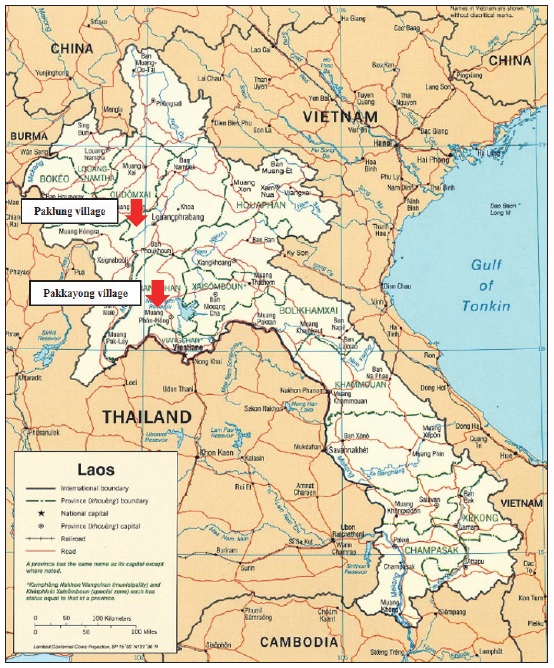
Note: The marked areas are Paklung village and Pakkayong village.
Source: U.S. Central Intelligence Agency.
Table 1.
Descriptive Statistics
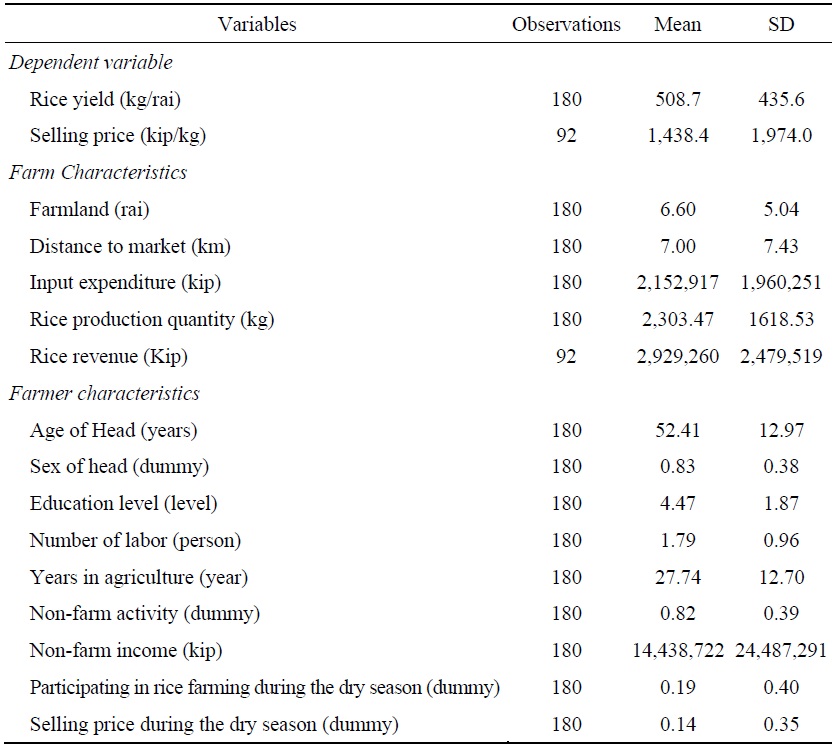
Notes: 1. One rai equals approximately 0.167 ha.
2. “Kip” is the currency of Lao PDR.
3. Education level: 1 = 1~2 years in elementary school, 2 = 3~4 years in elementary school, 3 = 5~6 years in primary school, 4 = 1~2 years in secondary school, 5 = 3~4 years in secondary school, 6 = 1~2 years in high school, 7 = 3 years in high school, 8 = university or more education
4. The unit of currency is Lao Kip as of 15 January 2018, USD 1 was equivalent to 8,120.70 Lao Kip
Table 2.
Agricultural Information Composition
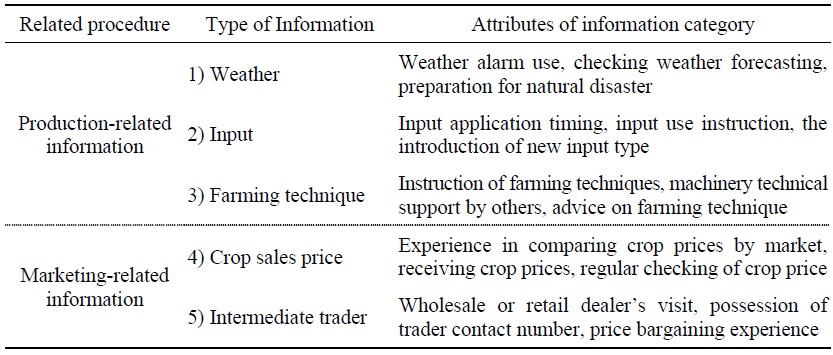
Table 3.
Summary Statistics of Respondents’ Agricultural Information

Note: It is a dummy variable whether or not using agricultural information.
Table 4.
Second-stage IV-2SLS and OLS Estimates of Rice Yield and Production-related Information Use
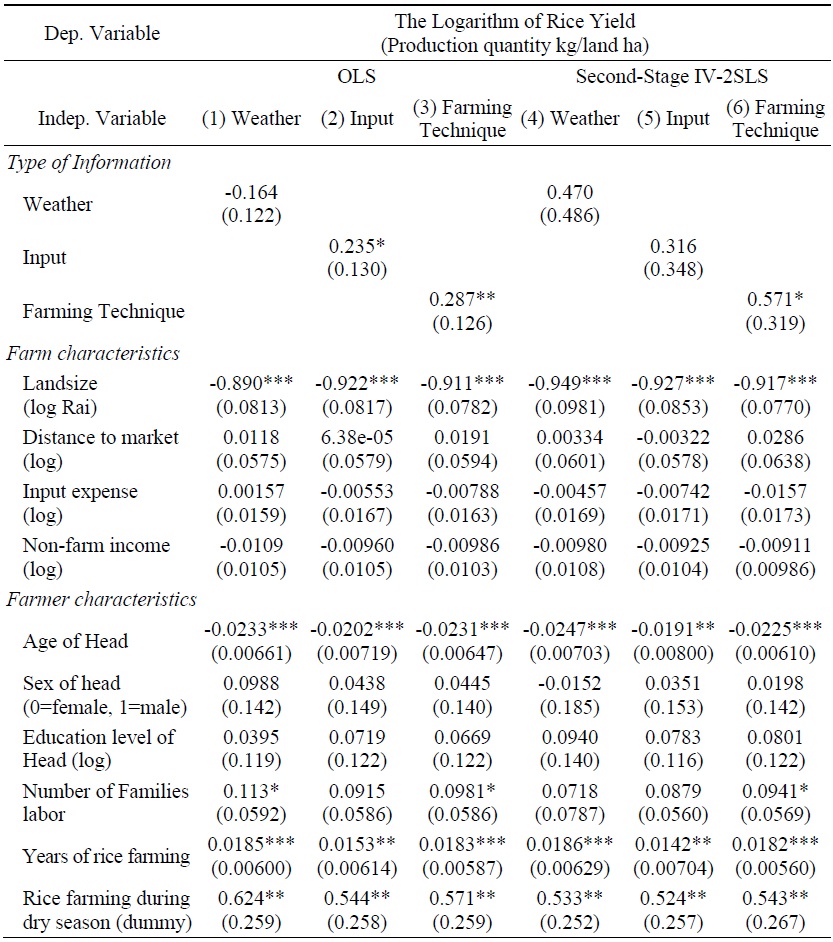
Table 4.
Continued
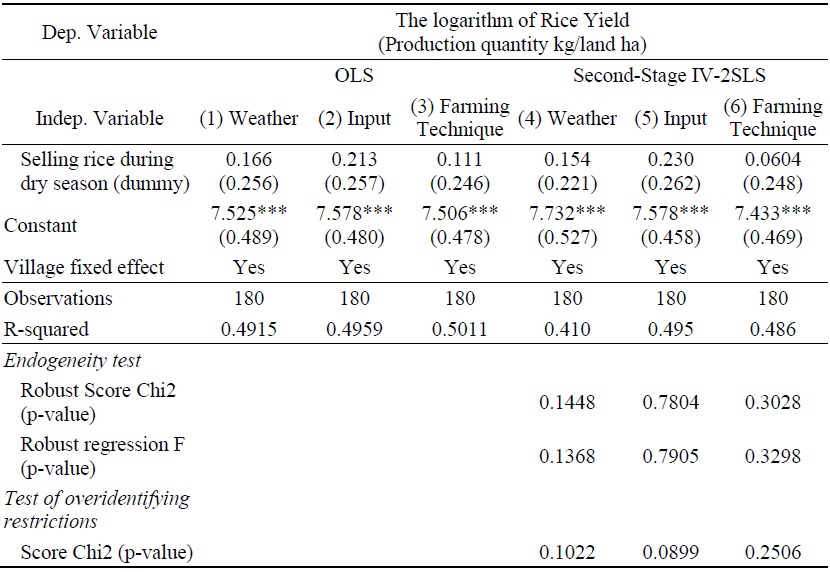
Note: Robust standard errors in parentheses (*** p<0.01, ** p<0.05, * p<0.1).
Table 5.
Second-stage IV-2SLS and OLS Estimates of Rice Selling Price and Marketing-related Information Use
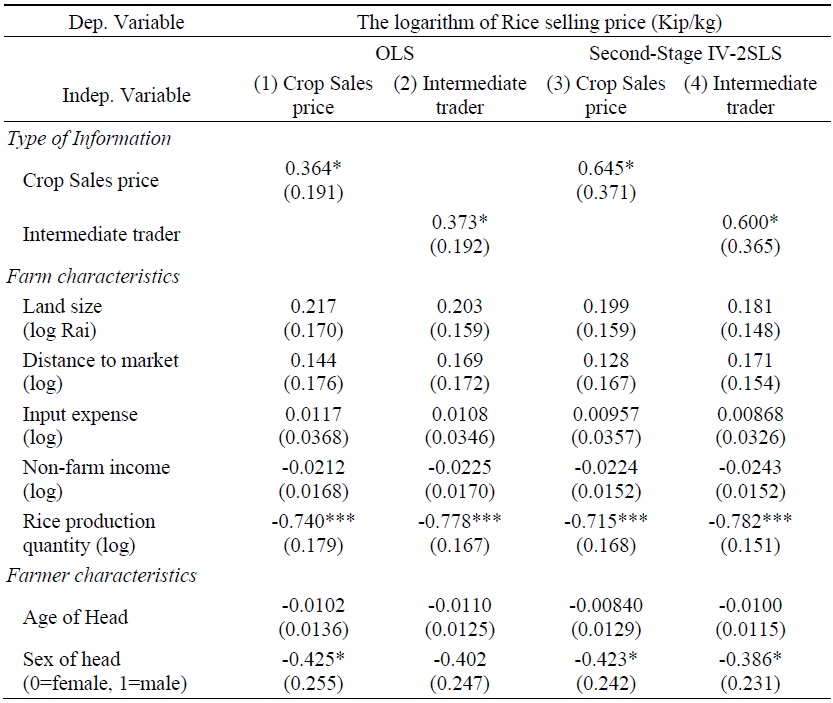
Table 5.
Continued
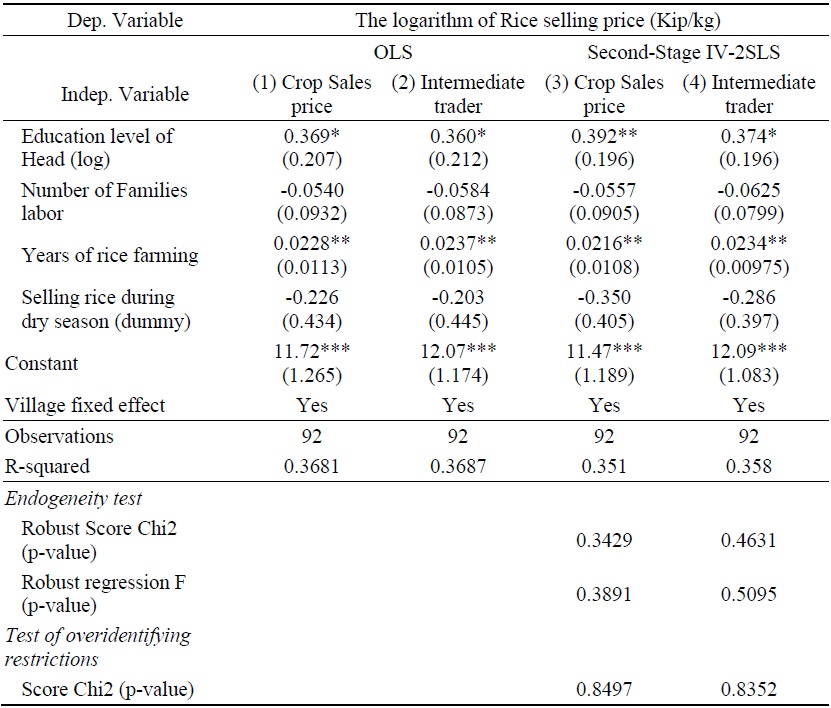
Note: Robust standard errors in parentheses (*** p<0.01, ** p<0.05, * p<0.1).
Figure 2.
Different Impact Evaluation between the One Considering Pre-existing Information and the Other Not Considering Pre-existing Information
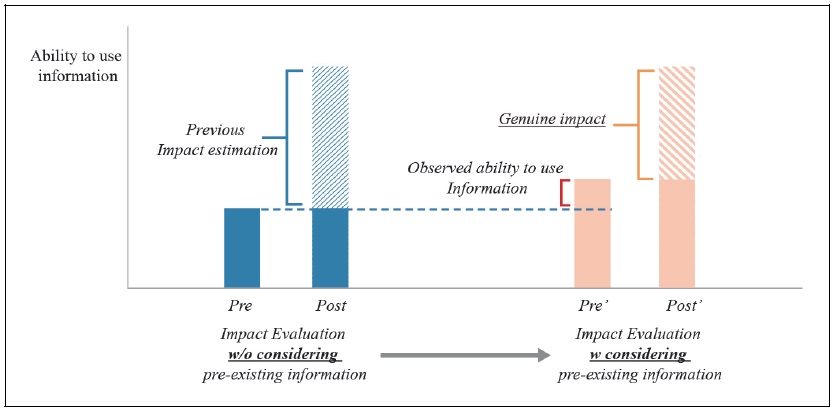
Note: by Author.
Table A1.
Percentage of Sources of Information Acquisition by Information
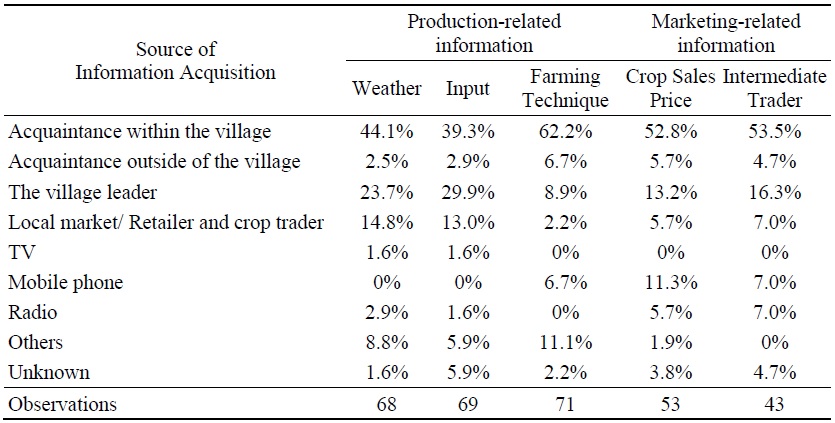
Notes: 1. The total number of household heads using production-related information and marketing-related information is different. Please refer to
2. In the case of the production-related information, there exists ‘local market’ as an answer choice instead of ‘retailer and crop trader’. Conversely, the ‘retailer and crop trader’ answer choice is in the answer choice for marketing-related information.
Table A2.
First-stage Results of IV: Production-related Information Use
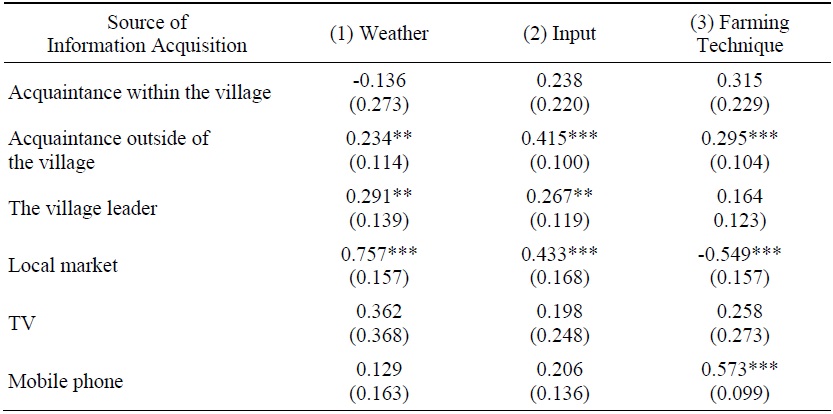
Table A2.
Continued
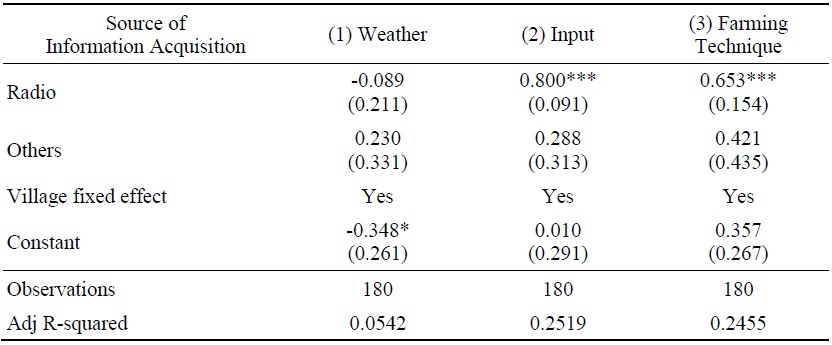
Notes: 1. Robust standard errors in parentheses (*** p<0.01, ** p<0.05, * p<0.1).
2. Information source is from unknown reference groups
Table A3.
First-Stage Results of IV: Marketing-related Information use
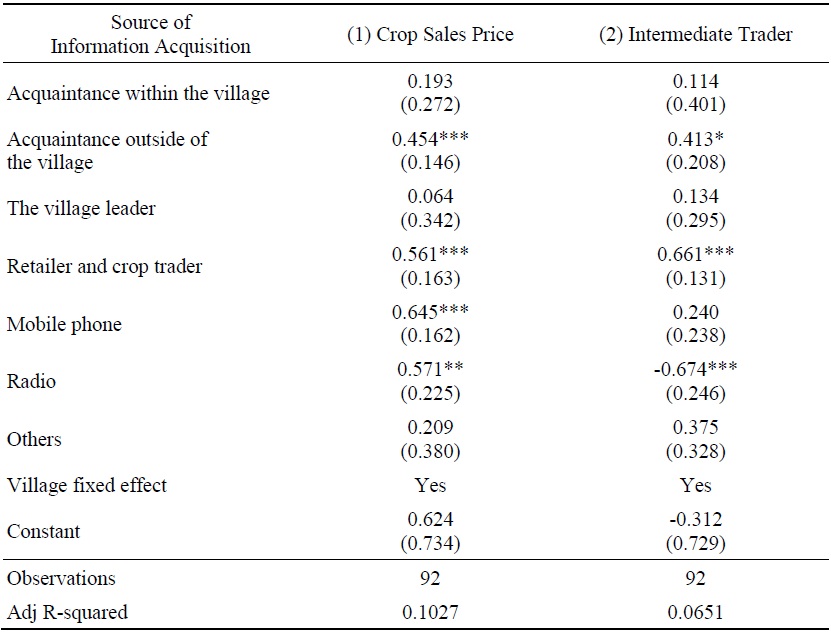
Note: Robust standard errors in parentheses (*** p<0.01, ** p<0.05, * p<0.1).
References
-
Abraham, R. 2006. “Mobile phones and economic development: Evidence from the fishing industry in India.” Paper presented at the 2006 International Conference on Information and Communication Technologies and Development. Berkeley, California. May 25-26. IEEE.
https://doi.org/10.1109/ICTD.2006.301837 -
Aker, J. C. 2010. “Information from markets near and far: mobile phones and agricultural markets in Niger.”
American Economic Journal: Applied Economics , vol. 2, no. 3, pp. 46-59.
-
Aker, J. C. and M. Fafchamps. 2015. “Mobile phone coverage and producer markets: evidence from West Africa.”
World Bank Economic Review , vol. 29, no. 2, pp. 262-292.https://doi.org/10.1093/wber/lhu006 
-
Aker, J. C. and C. Ksoll. 2016. “Can mobile phones improve agricultural outcomes? Evidence from a randomized experiment in Niger.”
Food Policy , vol. 60, pp. 44-51.https://doi.org/10.1016/j.foodpol.2015.03.006 
-
Aker, J. C. and I. M. Mbiti. 2010. “Mobile phones and economic development in Africa.”
Journal of Economic Perspective , vol. 24, no. 3, pp. 207-232.http://dx.doi.org/10.1257/jep.24.3.207 
-
Angrist, J. D. and J.-S. Pischke. 2009.
Mostly harmless econometrics: An empiricist’s companion . Princeton, NJ: Princeton University Press. -
Besley, T. 1995. “Property-Rights and Investment Incentives: Theory and Evidence from Ghana.”
Journal of Political Economy , vol. 103, no. 5, pp. 903-937.http://dx.doi.org/10.1086/262008 
-
Bourdet, Y. 2000.
The Economics of Transition in Laos: From Socialism to ASEAN Integration . Cheltenham, UK: Edward Elgar. -
Brasselle, A.-S., Gaspart, F. and J.-P. Platteau. 2002. “Land tenure security and investment incentives: puzzling evidence from Burkina Faso.”
Journal of Development Economics , vol. 67, no. 2, pp. 373-418.https://doi.org/10.1016/S0304-3878(01)00190-0 
-
Cole, S. A. and A. N. Fernando. 2012. “The value of Advice: Evidence from Mobile phone based agricultural extension.” Harvard Business School Working Paper, no. 13-047.
http://dx.doi.org/10.2139/ssrn.2179008 -
Cook, J. A. 2009. “Smallholder Agriculture and the Environment in a Changing Global Context.” WWF MPO, May 2009. World Wildlife Fund Macroeconomics Program Office.
https://wwfint.awsassets.panda.org/downloads/wwf_mpo_smallholder_ag_policy_brief.pdf -
Deaton, A. and G. Laroque. 1996. “Competitive storage and commodity price dynamics.”
Journal of Political Economy , vol. 104, no. 5, pp. 896-923.https://doi.org/10.1086/262046 
- Dimova, R. and K. Sen. 2010. “Is household income diversification a means of survival or a means of accumulation? Panel data evidence from Tanzania.” BWPI Working Paper, no. 122. Brooks World Poverty Institute, The University of Manchester.
-
Fafchamps, M. and B. Minten. 2012. “Impact of SMS-based agricultural information on Indian farmers.”
World Bank Economic Review , vol. 26, no. 3, pp. 383-414.https://doi.org/10.1093/wber/lhr056 
-
Gadeng, A. N., Maryani, E. and D. Rohmat. 2018. “The value of local wisdom smong in tsunami disaster mitigation in Simeulue Regency, Aceh Province.” Paper presented at the 1st UPI International Geography Seminar 2017. August 8. Indonesia.
IOP Conference Series: Earth and Environmental Science , vol. 145.https://doi.org/10.1088/1755-1315/145/1/012041 
-
Goyal, A. 2010. “Information, direct access to farmers, and rural market performance in Central India.”
American Economic Journal: Applied Economics , vol. 2, no. 3, pp. 22-45.https://doi.org/10.1257/app.2.3.22 
- Harris, D. N. 2011. “Extending rice crop yield improvements in Lao PDR: an ACIAR–World Vision collaborative project.” ACIAR Impact Assessment Series Report, no. 75. Australian Centre for International Agricultural Research, Australian Government.
-
Hasanah, S., Yani, A. and I. Setiawan. 2021. “Water conservation based on local wisdom in Cikondang traditional village community.” Paper presented at the International Geography Seminar 2019. August 31, 2019. Lor in Hotel Solo, Indonesia.
IOP Conference Series: Earth and Environmental Science , vol. 683.
-
Jackson, L. A., Zhao, Y., Kolenic, A., Fitzgerald, H. E., Harold, R. and A. VonEye. 2008. “Race, Gender, and Information Technology Use: The New Digital Divide.”
CyberPsychology & Behavior , vol. 11, no. 4, pp. 437-442.https://doi.org/10.1089/cpb.2007.0157 
-
Jaitae, S. 2016. “The local wisdom agriculture of farmer at Muang kaen Municipality Maetang district, Chiang Mai.”
Journal of Agricultural Research and Extension , vol. 33, no. 3, pp. 64-72.https://www.cabdirect.org/cabdirect/abstract/20193172357 (In Thai) -
Jensen, R. 2007. “The digital provide: information (technology), market performance, and welfare in the South Indian fisheries sector.”
Quarterly Journal of Economics , vol. 122, no. 3, pp. 879-924.https://doi.org/10.1162/qjec.122.3.879 
-
Kanz, M. 2016. “What does debt relief do for development? Evidence from India's bailout for rural households.”
American Economic Journal: Applied Economics , vol. 8, no. 4, pp. 66-99.https://doi.org/10.1257/app.20130399 
-
Kassie, M., Shiferaw, B. and G. Muricho. 2011. “Agricultural Technology, Crop Income, and Poverty Alleviation in Uganda.”
World Development , vol. 39, no. 10, pp. 1784-1795.https://doi.org/10.1016/j.worlddev.2011.04.023 
-
Kirui, O. K., Okello, J. J. and R. A. Nyikal. 2013. “Impact of mobile phone-based money transfer services in agriculture: evidence from Kenya.”
Quarterly Journal of International Agriculture , vol. 52, no. 2, pp. 141-162. -
Klonner, S. and P. J. Nolen. 2010. “Cell phones and rural labour markets: evidence from South Africa.” In the proceedings of the German Development Economics Conference. Hannover.
https://ideas.repec.org/p/zbw/gdec10/56.html -
Lamptey, R. B., Sambo, I. A. and A. A. Hassan. 2017. “Disseminating and promoting agriculture information through library and information services in Ghana.”
Qualitative and Quantitative Methods in Libraries , vol. 5, no. 4, pp. 901-907.http://www.qqml.net/index.php/qqml/article/view/15 -
Lao PDR Ministry of Agriculture and Forestry (LMAF). 2010. “Strategy for Agricultural Development 2011 to 2020: Agriculture and Forestry for Sustainable Development, Food and Income Security, Vientiane, August 19, 2010.”
https://www.gafspfund.org/sites/default/files/inline-files/5.%20LaoPDR_strategy.pdf -
Lao PDR Ministry of Agriculture and Forestry (LMAF). 2015. “Agriculture development strategy to 2025 and vision to the year 2030.”
https://www.maf.gov.la/wp-content/uploads/2016/01/MDS-2025-and-Vision-to-2030-Eng.pdf -
Lee, K. H. and M. F. Bellemare. 2013. “Look who’s talking: the impacts of the intrahousehold allocation of mobile phones on agricultural prices.”
Journal of Development Studies , vol. 49, no. 5, pp. 624-640.https://doi.org/10.1080/00220388.2012.740014 
-
Markussen, T. 2008. “Property Rights, Productivity, and Common Property Resources: Insights from Rural Cambodia.”
World Development , vol. 36, no. 11, pp. 2277-2296.https://doi.org/10.1016/j.worlddev.2008.04.008 
-
Martin, G. J. 2014.
Ethnobotany: a methods manual . Boston: Springer. -
Messerli, P., Heinimann, A. and M. Epprecht. 2009. “Finding homogeneity in heterogeneity-A new approach to quantifying landscape mosaics developed for the Lao PDR.”
Human Ecology , vol. 37, pp. 291-304.https://doi.org/10.1007/s10745-009-9238-1 
-
Minah, S., Norjietta, T., Rosliah, K. and S. K. I. Novi. 2019. “Local wisdom in agriculture for environmental sustainability: A case study of the Dusun community.”
International Journal of Innovation, Creativity and Change , vol. 6, no. 8, pp. 117-138.https://www.ijicc.net/images/Vol6Iss8/6810_Minah_2019_E_R.pdf -
Mittal, S. and G. Tripathi. 2009. “Role of Mobile Phone Technology in Improving Small Farm Productivity.”
Agricultural Economics Research Review , vol. 22, no. conference, pp. 451-459.https://www.indianjournals.com/ijor.aspx?target=ijor:aerr&volume=22&issue=conf&article=015 -
Mungmachon, M. R. 2012. “Knowledge and local wisdom: Community treasure.”
International Journal of Humanities and Social Science , vol. 2, no. 13, pp. 174-181.http://www.ijhssnet.com/view.php?u=https://www.ijhssnet.com/journals/Vol_2_No_13_July_2012/18.pdf -
Muto, M. and T. Yamano. 2009. “The impact of mobile phone coverage expansion on market participation: Panel data evidence from Uganda.”
World development , vol. 37, no. 12, pp. 1887-1896.https://doi.org/10.1016/j.worlddev.2009.05.004 
- Najdov, E. and K. Phimmahasay. 2016. “Lao Economic Monitor: Challenges in promoting more inclusive growth and shared prosperity: Thematic Secton-drivers of proverty reduction in Lao PDR.” Working Paper, no. AUS17628. World Bank.
- Nelson, G. C., Rosegrant, M. W., Koo, J., Robertson, R., Sulser, T., Zhu, T., Ringler, C., Msangi, S., Palazzo, A., Batka, M., Magalhaes, M., Valmonte-Santos, R., Ewing, M. and D. Lee. 2009. “Climate Change Impact on Agriculture and Costs of Adaptation, Appendix 2: Results by World Bank Regional Grouping of countries.” Food Policy Report. International Food Policy Research Institute.
-
Ogutu, S. O., Okello, J. J. and D. J. Otieno. 2014. “Impact of information and communication technology-based market information services on smallholder farm input use and productivity: The case of Kenya.”
World Development , vol. 64, pp. 311-321.https://doi.org/10.1016/j.worlddev.2014.06.011 
-
Overa, R. 2006. “Networks, distance, and trust: telecommunications development and changing trading practices in Ghana.”
World Development , vol. 34, no. 7, pp. 1301-1315.https://doi.org/10.1016/j.worlddev.2005.11.015 
-
Pande, D. 2019. “Impact of the agriculture debt waiver debt relief scheme on the consumption expenditure of smallholder farmers.”
Agricultural Economics Research Review , vol. 32, no. conference, pp. 103-112.https://www.doi.org/10.5958/0974-0279.2019.00020.X 
-
Phimphanthavong, H. 2012. “Economic Reform and Regional Development of Laos.”
Modern Economy , vol. 3, no. 2, pp. 179-186.https://www.doi.org/10.4236/me.2012.32025 
-
Roller, L.-H. and L. Waverman. 2001. “Telecommunications infrastructure and economic development: A simultaneous approach.”
American Economic Review , vol. 91, no. 4, pp. 909-923.http://doi.org/10.1257/aer.91.4.909 
-
Shimamoto, D., Yamada, H. and M. Gummert. 2015. “Mobile phones and market information: Evidence from rural Cambodia.”
Food Policy , vol. 57, pp. 135-141.https://doi.org/10.1016/j.foodpol.2015.10.005 
-
Sharma, S. D. 2005. “Agricultural Development for Inclusive Growth: A Strategy for Achieving the Millenium Development Goals.”
East Asian Economic Review , vol. 9, no. 1, pp. 59-84.https://dx.doi.org/10.11644/KIEP.JEAI.2005.9.1.136 
-
Situmorang, R. O. P., Harianja, A. H. and J. Silalahi. 2015. “Karo’s local wisdom: The use of woody plants for traditional diabetic medicines.”
Indonesian Journal of Forestry Research , vol. 2, no. 2, pp. 121-130.
-
Susilawati, P. N., Yursak, Z. and U. D. Amanda. 2020. “Local rice conservation through local wisdom of indigenous culture in Kasepuhan Cisungsang, Banten Province, Indonesia.” Paper presented at the 7th Symposium of Japan-ASEAN Science Techonology Innovation Platform. 24 October, 2019. Tangerang, Indonesia.
IOP Conference Series: Earth and Environmental Science , vol. 591.
-
Svensson, J. and D. Yanagizawa. 2009. “Getting prices right: the impact of the market information service in Uganda.”
Journal of the European Economic Association , vol. 7, no. 2-3, pp. 435-445.https://doi.org/10.1162/JEEA.2009.7.2-3.435 
-
Stigler, G. J. 1961. “The economics of information.”
Journal of Political Economy , vol. 69, no. 3, pp. 213-225.https://www.jstor.org/stable/i304798 
-
Southiseng, N. and J. Walsh. 2010. “Competition and Management Issues of SME Entrepreneurs in Laos: Evidence from Empirical Studies in Vientiane Municipality, Savannakhet and Luang Prabang.”
Asian Journal of Business Management , vol. 2, no. 3, pp. 57-72.https://maxwellsci.com/jp/abstract.php?jid=AJBM&no=68&abs=02 -
Tack, J. B. and J. C. Aker. 2014. “Information, Mobile Telephony and traders’ search behavior in Niger.”
American Journal of Agricultural Economics , vol. 96, no. 5, pp. 1439-1454.https://doi.org/10.1093/ajae/aau063 
-
Tang, C. S., Wang, Y. and M. Zhao. 2015. “The implications of utilizing market information and adopting agricultural advice for farmers in developing economies.”
Production and Operations Management , vol. 24, no. 8, pp. 1197-1215.
-
U.S. Central Intelligence Agency. n.d. Perry-Castaneda Libaray Map Collection-Laos Maps [files]. University of Texas Libraries, University of Texas at Austin.
http://legacy.lib.utexas.edu/maps/laos.html (Accessed 2016) -
Wooldridge, J. M. 2010.
Econometric analysis of cross section and panel data . Cambridge, Mass.: MIT press. -
World Food Programme (WFP). n.d. Lao PDR Country Strategic Plan 2017-2021 [files].
https://www.wfp.org/operations/la01-laos-country-strategic-plan-2017-2021 -
Zulfadrim, Z., Toyoda, Y. and H. Kanegae. 2018. “The implementation of local wisdom in reducing natural disaster risk: a case study from West Sumatera.” Paper Presnted at the 4th International Seminar on Sustainable Urban Development. August 9-10, 2017. Jakarta, Indonesia.
IOP Conference Series: Earth and Environmental Science , vol. 106.



